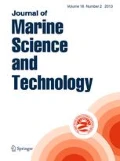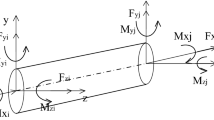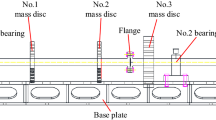Abstract
In recently constructed vessels, minimization of engine room volume is required to maximize the volume of cargo to be shipped. Therefore, the main engine and the stern bulkhead mounted on the ship are installed as far as possible in the aftward direction. As a result, the length of the propeller shaft is reduced, along with the stern tube bearing span used to support it. In this case, the shaft flexibility is reduced, the reaction influence number is increased, and the point load of each bearing is easily influenced by change in displacement. Because the point load of each bearing is susceptible to hull deformation and thermal expansion, it is difficult to adjust the shaft arrangement and the bearing load change after large adjustment of the shaft arrangement. Therefore, in the past, the bearing was arranged to support the propeller shaft with two forward and afterward stern tube bearings. However, when the main engine and the stern bulkhead are installed as far aftward as possible to minimize the volume of the engine room, it is necessary to provide shaft flexibility by removing the forward stern tube bearing. As a result, the resonance revolution of the propeller blades during whirling vibration of the propulsion shafting system falls within the range of normal operating revolutions. This means that abnormal wear of the stern tube bearing, damage to the stern tube sealing device, and hull structure vibration may occur due to the whirling vibration. In this paper, the characteristics of shafting alignment and whirling vibration of a ship supporting a propeller shaft with double and single stern tube bearings are compared. Moreover, the changes in shaft flexibility and the characteristics of the whirling vibration of a corresponding shafting system in a 50 K-DWT petroleum product tanker were explored by applying a single stern tube bearing. In addition, the shafting alignment and whirling vibration are determined according to the installation position of the intermediate shaft bearing. A method is suggested for selecting the optimal shafting arrangement by which to secure the shaft flexibility of a ship to which a single stern tube bearing is applied, and to avoid resonance from the whirling vibration.





















Similar content being viewed by others
Abbreviations
- DWT:
-
Deadweight
- RIN:
-
Reaction influence number
- PCT:
-
Product chemical tanker
- POT:
-
Product oil tanker
- COT:
-
Crude oil tanker
- VLCC:
-
Very large crude oil carrier
- MB:
-
Main bearing
- FR.:
-
Frame
- \(P_{1} - P_{4}\) :
-
External force acting on a node
- \(U_{p1} - U_{p4}\) :
-
Displacement of nodes
- \(f_{{{\text{f}}a1}}\) :
-
Section force at a1 stage
- K :
-
Stiffness matrix
- U :
-
Displacement row matrix
- P :
-
External force row matrix
- f :
-
Section force row matrix
- F :
-
Force row matrix
- R :
-
Bearing load after alignment
- \(\dot{R}\) :
-
Initial bearing load
- \(\left[ M \right]\) :
-
Total mass matrix
- \(\left[ K \right]\) :
-
Total stiffness matrix
- \(I_{\text{p}}\) :
-
Moment of inertia of propeller (kg m2)
- \(I_{\text{d}}\) :
-
Moment of inertia about propeller diameter (kg m2)
- \(L_{\text{stb}}\) :
-
Distance between forward and afterward stern tube bearing (mm)
- \(L_{\text{i}}\) :
-
Distance between forward stern tube bearing and intermediate shaft bearing (mm)
- \(d_{\text{p}}\) :
-
Diameter of propeller shaft (mm)
- \(d_{\text{i}}\) :
-
Diameter of intermediate shaft (mm)
- \(k_{aa1}\) :
-
Force to be applied to a1 point in order to cause a unit displacement at a1 point
- \(k_{ab1}\) :
-
Force to be applied to b1 point in order to cause a unit displacement at a1 point
- \(\omega\) :
-
Natural frequency (cpm)
- \(\delta\) :
-
Height variation in bearing
- m :
-
Propeller mass (kg)
- \(\mu\) :
-
Mass per unit length of shaft (kg)
- \(f_{\text{mp}}\) :
-
Natural frequency by Panagopoulos method (cpm)
- \(\dot{m}\) :
-
Equivalent mass of shaft (kg)
- p :
-
Natural frequency by Jasper–Rayleigh method (cpm)
- \(\varOmega\) :
-
Propeller angular velocity
- \(\alpha\) :
-
Deflection when a unit force is applied to the tip of the propeller
- \(\beta\) :
-
Angle of deflection when a unit force is applied to the tip of the propeller
- \(\gamma\) :
-
Angle of deflection when a unit moment is applied to the tip of the propeller
References
Mourelatos Z, Papalambros P (1985) A mathematical model for optimal strength and alignment of marine shafting system. J Ship Res 29(3):212–222
Larsen OC (1981) Some considerations on marine shafting design. Ind Lubr Tribol 33(5):164–171
Mann G (1964) Design of propulsion shaft systems using fair curve alignment theory. Am Soc Nav Eng J 76(6):851–862
Mann G (1965) Analysis of shafting problems using fair curve alignment theory. Am Soc Nav Eng J 77(1):117–133
Mann G (1965) Shipyard alignment of propulsion shafting using fair curve alignment theory. Nav Eng J 77(4):651–659
Korean Register (2012) Control of ship vibration and noise, 3rd edn. Textbook Publisher, Seoul (in Korean)
Kim JR (2003) Lateral vibration and shaft alignment on the propulsion shafting system. J Korean Soc Mar Eng 27(2):198–208 (in Korean)
Sun JS, Lee YJ, Kim UK (2009) The flexibility estimation of alignment for propulsion shafting system using the approximated hull deflection curve. J Korean Soc Mar Eng 33(1):28–36 (in Korean)
Shin SH, Ko DE (2017) A study on flexibility acquisition method for VLCC shaft system. J Korea Acad Ind Cooperation Soc 8(12):135–139 (in Korean)
Murawski L (2005) Shaft line alignment analysis taking ship construction flexibility and deformations into consideration. Mar Struct 18:62–84
Choung JM, Choe IH (2007) Pressure analysis of stern tube after bush bearing considering elastic deflection of misaligned journal and partial slope of bearing bush. J Soc Nav Archit Korea 44(6):666–674 (in Korean)
Shin SH (2015) Effects of propeller forces on the propeller shaft bearing during going straight and turning of ship. J Soc Nav Archit Korea 52(1):61–69 (in Korean)
Choung JM, Choe IH, Kim KC (2005) Verification of effective support points of stern tube bearing using nonlinear elastic multi-support bearing elements. J Soc Nav Archit Korea 42(5):479–486 (in Korean)
Kang DC, Park KW, Kim KH (2005) The introduction of shaft alignment calculation for very large container vessel. In: Special issue of the society of naval architect of Korea, pp 138–143 (in Korean)
Sverko D (2003) Design concerns in propulsion shafting alignment, ABS technical papers 2003. American Bureau of Shipping, Houston
Kim KS, Hum YJ, Kang JK, Heo HJ (2005) Study of the effect of crankshaft model in shaft alignment analysis. In: Special issue of the society of naval architect of Korea, pp 206–210 (in Korean)
Son ST, Kil BL, Kim JR (2007) A study on the analysis of axial vibration of flexible shafting system for propulsion and lift in air cushion vessel. J Korean Soc Mar Eng 31(6):768–776 (in Korean)
Son ST, Kim JR (2007) A study on the analysis of torsional vibration of branched shafting system for propulsion and lift in air cushion. J Korean Soc Mar Eng 31(4):335–342 (in Korean)
Son ST, Kil BL, Cho KH, Kim JR (2008) A study on the analysis of lateral vibration of flexible shafting system for propulsion and lift in air cushion vessel. J Korean Soc Mar Eng 32(2):241–249 (in Korean)
Huang Q, Yan X, Wang Y, Zhang C, Jin Y (2016) Numer ical and experimental analysis of coupled transverse and longitudinal vibration of a marine propulsion shaft. J Mech Sci Technol 30(12):5405–5412
Sun JS, Han TM, Lee KK, Kim UK (2015) A study on the measurement and analysis of whirling vibration behavior of marine propulsion shafting system using gap-sensors. J Korean Soc Mar Eng 39(2):130–135
Kim DH, Lee CM, Choi HJ (2013) Static and dynamic analysis and optimization design of 40,000-rpm high speed spindle for machine tools. Trans Korean Soc Mech Eng A 37(1):105–111 (in Korean)
Lim JG, Yoon WS, Beom HR, Hong SW (2011) A study on suppression of lateral vibration for axially deploying beams under gravity. J Korean Soc Precis Eng 28(8):959–965
Lehr WE, Parker EL (1961) Considerations in the design of marine propulsion shaft systems. Int J Soc Nav Archit Mar Eng 69:555–601
American Bureau of Shipping (2002) Theoretical backgrounds shaft alignment program ShAl Ver-1.1. American Bureau of Shipping, Houston
Moon DH, Jeon HJ (1981) A study on the propulsion shaft alignment calculation by the matrix method of three-moment theory. J Korean Soc Mar Eng 5(1):1–8 (in Korean)
Jeon HJ, Park JG, Choi JS (1978) Optimum alignment of marine engine shaftings by the finite element method. J Korean Soc Mar Eng 2(1):1–14 (in Korean)
Jeon HJ, Kim HC (1978) Calculation of transverse vibration of ship’s propulsion shaftings by the finite element method. J Korean Soc Mar Eng 3(1):1–18 (in Korean)
Panagopulos E (1950) Design stage calculation of torsional, axial and lateral vibration of marine shafting. Trans Soc Nav Archit Mar Eng 58:329–384
Jasper NH (1952) An experimental and theoretical investigation of propeller shaft failures. Trans Soc Nav Archit Mar Eng 60:314–381
Jasper NH (1954) A theoretical approach to the problem of critical whirling speeds of shaft-desk systems. DTMB report 890, David taylor model basin, United States of America
Jasper NH (1954) A design approach to the problem of critical whirling speeds of shaft-desk systems. DTMB report 890, David taylor model basin, United States of America
Ahn SY, Jeon HJ (1983) Calculation of the coupled free, transverse vibrations of the multi-supported shaft system by transfer matrix method. J Korean Soc Mar Eng 7(1):49–63 (in Korean)
Hori Y, Tanaka M (1976) Lateral vibrations of propeller shaft system. J Mar Eng Soc Japan 11(5):376–384
Saitoh T, Mizuuchi M, Matsumoto K, Najai M, Yoshioka M, Shigemi T (1978) Whirling of propeller shaftings. J Mar Eng Soc Japan 13(12):903–917 (in Japanese)
Den Hartog JP (1956) Mechanical vibration. McGraw-Hill Book Co., New York
Author information
Authors and Affiliations
Corresponding author
Additional information
Publisher's Note
Springer Nature remains neutral with regard to jurisdictional claims in published maps and institutional affiliations.
About this article
Cite this article
Kim, YG., Kim, UK. Design and analysis of the propulsion shafting system in a ship with single stern tube bearing. J Mar Sci Technol 25, 536–548 (2020). https://doi.org/10.1007/s00773-019-00659-8
Received:
Accepted:
Published:
Issue Date:
DOI: https://doi.org/10.1007/s00773-019-00659-8




